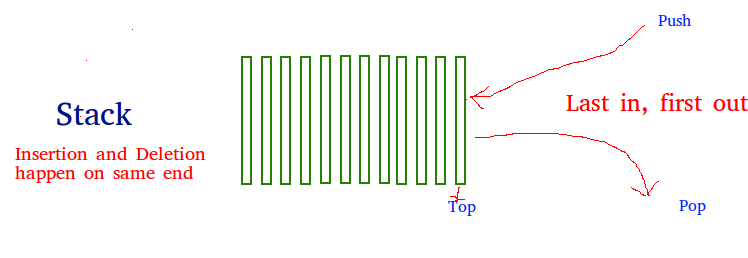Hi everyone, inside this article we will see the concept about Stacks Data Structure.
A stack is a linear data structure in computer science that follows the Last-In-First-Out (LIFO) principle. In other words, the last element that is inserted into the stack will be the first element to be removed.
A stack can be thought of as a collection of elements that are stacked on top of each other. The last element inserted into the stack is at the top, and the first element inserted into the stack is at the bottom.
Stacks are used in a wide range of computer science applications such as parsing expressions, depth-first search algorithms, function calls, undo and redo functionality in text editors, and many more.

A stack has two primary operations, which are:
- Push: This operation adds an element to the top of the stack.
- Pop: This operation removes the top element from the stack.
In addition to these two primary operations, there are a few more operations that can be performed on a stack, such as:
- Peek: This operation returns the top element of the stack without removing it.
- Size: This operation returns the number of elements in the stack.
- Is Empty: This operation checks whether the stack is empty or not.
Stacks are often implemented using arrays or linked lists. An array-based stack has a fixed size, whereas a linked list-based stack can grow and shrink dynamically as elements are added or removed. Choosing the appropriate implementation depends on the requirements of the specific application.
Some Key Points Related to Stack of Data Structure
Here are some key points related to stacks in data structure:
- A stack is a linear data structure that follows the Last-In-First-Out (LIFO) principle.
- A stack has two primary operations: push and pop. The push operation adds an element to the top of the stack, and the pop operation removes the top element from the stack.
- In addition to push and pop, there are other operations that can be performed on a stack, such as peek, size, and is empty.
- Stacks are used in a wide range of computer science applications such as parsing expressions, depth-first search algorithms, function calls, undo and redo functionality in text editors, and many more.
- Stacks can be implemented using arrays or linked lists. An array-based stack has a fixed size, whereas a linked list-based stack can grow and shrink dynamically as elements are added or removed.
- Stacks are often used in conjunction with other data structures, such as queues and trees, to solve complex problems.
- The time complexity of the push, pop, peek, size, and is empty operations in a stack is O(1) in the average and worst case.
- A stack can be implemented using recursion, which is a powerful programming technique that allows a function to call itself.
- A stack can be visualized as a pile of books or plates, where the last book or plate added is on the top, and the first book or plate added is at the bottom.
We hope this article helped you to understand about Stacks Data Structure in a very detailed way.
Online Web Tutor invites you to try Skillshike! Learn CakePHP, Laravel, CodeIgniter, Node Js, MySQL, Authentication, RESTful Web Services, etc into a depth level. Master the Coding Skills to Become an Expert in PHP Web Development. So, Search your favourite course and enroll now.
If you liked this article, then please subscribe to our YouTube Channel for PHP & it’s framework, WordPress, Node Js video tutorials. You can also find us on Twitter and Facebook.
